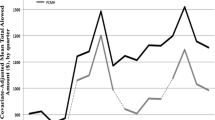Abstract
Background
The patient centered medical home has received considerable attention as a potential way to improve primary care quality and limit cost growth. Little information exists that systematically compares PCMH pilot projects across the country.
Design
Cross-sectional key-informant interviews.
Participants
Leaders from existing PCMH demonstration projects with external payment reform.
Measurements
We used a semi-structured interview tool with the following domains: project history, organization and participants, practice requirements and selection process, medical home recognition, payment structure, practice transformation, and evaluation design.
Results
A total of 26 demonstrations in 18 states were interviewed. Current demonstrations include over 14,000 physicians caring for nearly 5 million patients. A majority of demonstrations are single payer, and most utilize a three component payment model (traditional fee for service, per person per month fixed payments, and bonus performance payments). The median incremental revenue per physician per year was $22,834 (range $720 to $91,146). Two major practice transformation models were identified—consultative and implementation of the chronic care model. A majority of demonstrations did not have well-developed evaluation plans.
Conclusion
Current PCMH demonstration projects with external payment reform include large numbers of patients and physicians as well as a wide spectrum of implementation models. Key questions exist around the adequacy of current payment mechanisms and evaluation plans as public and policy interest in the PCMH model grows.

Similar content being viewed by others
References
Bodenheimer T, Grumbach K, Berenson RA. A lifeline for primary care. N Engl J Med. 2009;360(26):2693–6.
Hauer KE, et al. Factors associated with medical students’ career choices regarding internal medicine. Jama. 2008;300(10):1154–64.
Lipner RS, et al. Who is maintaining certification in internal medicine–and why? A national survey 10 years after initial certification. Ann Intern Med. 2006;144(1):29–36.
McGlynn EA, et al. The quality of health care delivered to adults in the United States. N Engl J Med. 2003;348(26):2635–45.
Ginsburg JA, et al. Achieving a high-performance health care system with universal access: what the United States can learn from other countries. Ann Intern Med. 2008;148(1):55–75.
Rittenhouse DR, Shortell SM. The patient-centered medical home: will it stand the test of health reform? Jama. 2009;301(19):2038–40.
Fisher ES. Building a medical neighborhood for the medical home. N Engl J Med. 2008;359(12):1202–05.
Berenson RA, et al. A house is not a home: keeping patients at the center of practice redesign. Health Aff (Millwood). 2008;27(5):1219–30.
American Academy of Family Physicians (AAFP) et al. Joint principles of the patient-centered medical home. 2007 [cited November 20th, 2009]; Available from: http://www.acponline.org/running_practice/pcmh/demonstrations/jointprinc_05_17.pdf.
Rosenthal TC. The medical home: growing evidence to support a new approach to primary care. J Am Board Fam Med. 2008;21(5):427–40.
Paulus RA, Davis K, Steele GD. Continuous innovation in health care: implications of the Geisinger experience. Health Aff (Millwood). 2008;27(5):1235–45.
Nutting PA, et al. Initial lessons from the first national demonstration project on practice transformation to a patient-centered medical home. Ann Fam Med. 2009;7(3):254–60.
Steiner BD, et al. Community care of North Carolina: improving care through community health networks. Ann Fam Med. 2008;6(4):361–7.
Reid R, et al. Patient-centered medical home demonstration: a prospective, quasi-experimental, before and after evaluation. Am J Manag Care. 2009;15(9):e71–89.
PCPCC. Patient centered medical home: building evidence and momentum. 2009 [cited June 5, 2009]; Available from: http://www.pcpcc.net/content/pcpcc_pilot_report.pdf.
ACP. Patient centered medical home. 2009 [cited June 5, 2009]; Available from: http://www.acponline.org/running_practice/pcmh/.
Chin MH, et al. Improving and sustaining diabetes care in community health centers with the health disparities collaboratives. Med Care. 2007;45(12):1135–43.
Coleman K, et al. Evidence on the chronic care model in the new millennium. Health Aff (Millwood). 2009;28(1):75–85.
Homer CJ, et al. Impact of a quality improvement program on care and outcomes for children with asthma. Arch Pediatr Adolesc Med. 2005;159(5):464–9.
Landon BE, et al. Improving the management of chronic disease at community health centers. N Engl J Med. 2007;356(9):921–934.
Mangione-Smith R, et al. Measuring the effectiveness of a collaborative for quality improvement in pediatric asthma care: does implementing the chronic care model improve processes and outcomes of care? Ambul Pediatr. 2005;5(2):75–82.
Vargas RB, et al. Can a chronic care model collaborative reduce heart disease risk in patients with diabetes? J Gen Intern Med. 2007;22(2):215–22.
Hroscikoski MC, et al. Challenges of change: a qualitative study of chronic care model implementation. Ann Fam Med. 2006;4(4):317–26.
Solberg LI, et al. Transforming medical care: case study of an exemplary, small medical group. Ann Fam Med. 2006;4(2):109–16.
Kuzel AJ, Skoch EM. Achieving a patient-centered medical home as determined by the NCQA–at what cost, and to what purpose? Ann Fam Med. 2009;7(1):85–6.
Acknowledgements
The authors would like to thank all of the survey respondents for their willingness to participate in the study. This study was funded in part by grants from the Agency for Health Care Research and Quality, the Commonwealth Fund, and The American Board of Internal Medicine Foundation. Dr. Bitton is supported by grant number T32HP10251 from the Health Resources and Services Administration of the Department of Health and Human Services to support the Harvard Medical School Fellowship in General Medicine and Primary Care. The study contents are solely the responsibility of the authors and do not necessarily represent the official views of the Department of Health and Human Services.
Conflict of Interest
None disclosed.
Author information
Authors and Affiliations
Corresponding author
Electronic Supplementary Material
Below is the link to the electronic supplementary material.
Appendix 1
Excluded Demonstration Projects (DOC 105 kb)
Appendix 2
Transformation Part I (DOC 89 kb)
Appendix 3
Transformation Part II (DOC 88 kb)
Rights and permissions
About this article
Cite this article
Bitton, A., Martin, C. & Landon, B.E. A Nationwide Survey of Patient Centered Medical Home Demonstration Projects. J GEN INTERN MED 25, 584–592 (2010). https://doi.org/10.1007/s11606-010-1262-8
Published:
Issue Date:
DOI: https://doi.org/10.1007/s11606-010-1262-8



